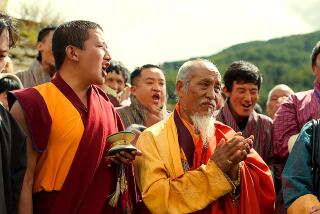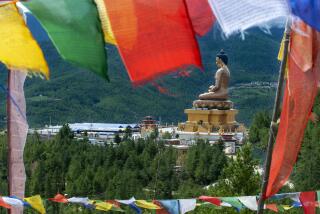Bhutan land of the thunder dragon
- Share via
ONGAR, Bhutan — Rolling, the sound reverberated like thunder. In the gloom of the eastern Bhutan twilight it dominated the terraced farmlands. Yet no rain cloud smudged the mauve-streaked sky. Instead the sound, insistent as a turbine’s whir, seemed to issue from a deserted wood-and-stone house.
No candles burned there. No dogs or children tumbled about. And as two uneasy passers-by stood outside, puzzling over whether the sound was natural or man-made, it seemed to move spookily, coming first from one direction, then another, as if the house were a ventriloquist throwing its voice. Finally the visitors called a bewildered retreat, but far down the dark trail the rolling sound could still be heard.
Like the sound, little-known Bhutan is a compelling enigma. Open to foreign visitors for less than 15 years, it remains a blend of Tibetan Buddhist tradition and measured development in the secluded eastern Himalayas.
Bhutan can still take pride in an essentially untouched culture, safeguarded from undue Western influence. But this longstanding isolation has sometimes left the area seriously misunderstood. In 1894, when only a handful of Westerners had yet penetrated the country, the British publication Sikhim Gazetteer declared: “Adventure looks beyond Bhutan.”
Nothing could have been more wrong. Barely one-tenth the size of California, Bhutan embodies a dreamer’s vision of allure and adventure. With shrewd foresight its government has severely restricted tourism, foreclosing the possibility of outsiders overrunning this tiny land.
Even so, Druk Yul (Land of the Thunder Dragon), as its inhabitants call it, has had difficulty holding the number of visitors to an annual capacity of about 2,600. It takes perseverance to visit, but with patience, one finds a substantial reward.
Citizens are open, good-humored and without pretense, extending generosity to strangers and friends alike. A teen-age girl from Paro, in western Bhutan, feels no more self-conscious about giving a guest her entire collection of the country’s remarkable postage stamps than an American host does in offering a glass of wine.
“No,” she insists when an exchange is proposed. “I do not need anything.”
Or again, as travelers are admonished by a sign at Thrimseng La, a 12,400-foot pass on the road to Mongar: “You are passing through the highest pass. Bash-on-regardless. Courtesy.”
Bhutan is a land of diversity, soaring from the dust and jungles of India to the stunning, 24,000-foot snow peaks that make up the spine of the Himalayas, and containing a rich variety of ethnic and linguistic groups. These differences are evident even before reaching the national airport at Paro on a Druk-Air flight from Calcutta or Dhaka. (This month, flights from New Delhi are also scheduled to start.)
After spending 1 1/2 hours droning over monochromatic tan fields, broken only by the sinuous curve of rivers in Bangladesh, green hills furrowed by ravines suddenly appear . . . and this is Bhutan. On roofs everywhere, bright red chili peppers dry for winter use. Tall white prayer flags flutter on hillsides in the clear air. Lavender cosmos and blood-red amaranthus bloom. Millet and rice are ready for harvest.
The 40-mile drive to the capital of Thimphu reveals a generally prosperous people, with bigger homes than others in much of southern Asia, neat fields and paddies, and a cleanliness and orderliness that can be appreciated by even the most finicky Westerner. Under government rules, tourists must be members of a group of at least six.
All visitors are looked after by the government-run Bhutan Tourism Corp., which charges each tourist $130 U.S. a day for meals, including lodging, transportation and a guide. Next year the government is raising the fee during peak season to about $250 daily.
Many monasteries, temples and other important religious sites are off-limits, in part because of concern that outsiders’ influence may erode traditional values. Nevertheless, visitors with a cultural bent can be amply satisfied, trekking and mountaineering expeditions are on the rise and white-water rafting is being introduced.
Thimphu, with 20,000 people, is a metropolis in a country still largely populated by small villages. There, travelers can see massive Tashichhodzong, the prime example of medieval monastery-fortresses, or dzongs, which still function as administrative and religious centers for the nation’s 18 districts.
The capital also is the site of the memorial chorten (shrine) to King Jigme Dorji Wangchuck, the present monarch’s father, a modern visionary who died in 1972 after a 20-year reign. One can see its white, onion-shaped dome for miles down the Thimphu Valley, which is about 8,000 feet above sea level.
It is particularly at the religious sites, no matter how modest, that one key to the internal life of the Bhutanese is evident. Abounding in ritual, Tibetan Buddhism influences virtually every aspect of life, and its eight “precious symbols” are ubiquitous. Boys as young as 5 or 6 become maroon-robed monks, and tulkus, accepted as reincarnations of especially holy lamas, are common.
Most Bhutanese are followers of the Kagyupa tradition, a different sect than that headed by the Dalai Lama. There is, however, a significant minority of ethnic Nepalis in the south that brings an element of Hinduism to part of the country.
But it is Buddhism that is perhaps the most visible common denominator between the country’s west and east. And in many ways, eastern Bhutan is as far removed from Thimphu as is Los Angeles.
Just getting to eastern Bhutan, generally not open to foreign visitors, requires several days of driving over serpentine Shunglung 1, the national highway, and that assumes that no rock slides have blocked or eradicated the way.
On the road to Mongar even the landscape seems determined to keep travelers off balance: Forests bearded in spring-green skeins of moss give way to steepening switchbacks, humpbacked hills and waterfalls by the score, followed by a rapid descent through bamboo and banana trees. Farther east the main town is Tashigang, set amid hills covered with weirdly contorted rock formations.
Ethnically, most easterners are of the Sharchop group instead of the more Tibetan-looking “pure” Bhutanese. Many do not speak Dzongkha, the national language, using instead their own Sharchopkha.
But east to west, if there must be one truism about Bhutan, it is that things are not always what they seem, and that lends a happy unpredictability to life. For every time you encounter a white ruff of fog instead of gorgeous mountain views, there is the equal amazement of being invited into a stranger’s home for innumerable cups of yak-butter tea.
A Popular King
Still, unpredictability does not translate to instability, at least in the political realm. For 14 years Bhutan’s 1.2 million inhabitants have been ruled by their enormously popular king, Jigme Singye Wangchuck, who is following in his forefathers’ footsteps of temperate development.
“Next to the desire for organic, harmonious progress, religion and tradition belong to our fundamental way of thinking,” the king said in a rare interview last year with the West German magazine Indo Asia.
Although publications about Bhutan are scarce, it is best to visit the country with a working knowledge of its ways.
Facts are difficult to come by and, conceded one Bhutanese familiar with the thinking of many tourist guides, “The tourists ask so many questions; sometimes we don’t know the answers. So we give them a good story.”
By far the two key historical figures are Padmasambhava, who converted Bhutan to Buddhism a millennium ago and who remains venerated on a scale with Buddha himself, and Ngawang Namgyel, who established a political hierarchy that lasted until this century.
From earliest times the Bhutanese have seemed to possess an extraordinary grace and attention to detail that extends from their painted architectural motifs to the way they choose vegetables in the Sunday market, handling each nourishing root as if it were a child.
Traditional Arts
In depicting their religious legends they rely on a cornucopia of traditional arts: hand-embroidered sacred cloths, or thangkas, as high as a three-story building; elaborate mystic mandalas of paint or colored powder, and, most lavish of all, the brilliantly costumed masked dances that are the centerpiece of the nation’s regional festivals, or tsechus.
Watching the Bhutanese at leisure also provides an excellent opportunity to understand what is important to them. When the men compete at archery, the national sport, they reveal a passion that makes Americans seem indifferent to football. The target is a short, narrow board about 150 yards from the archer.
If that does not make shooting tricky enough, the board is usually surrounded by half a dozen of the archer’s teammates, who laugh at the possibility of being impaled by an errant arrow. When the target is struck--and it often is by these superb marksmen--the teammates execute a victory minuet of such elegance and complexity that it is an athletic achievement all its own.
If the men demonstrate their skill and precision at archery, the women do so at weaving, producing from the back-strap looms of their homes vivid textiles of cotton, silk and wool in incredibly intricate patterns. Much of their efforts go into making the kho, or boku , a loose, knee-length belted robe that is the national dress for men, and the kira , the full-length equivalent for women, usually adorned with necklaces of chunky coral and turquoise.
In general, women enjoy a much higher status in Bhutan than in other Third World nations. Women are usually the ones who inherit family property; they also have virtually sole authority over all decisions involving children. Yet it is considered an ill omen if a prayer flag touches a woman’s clothes, and women are not allowed inside the dzongs after dark.
Simple, Spicy Food
Both Bhutanese women and men enjoy food that is simple and spicy. Travelers inclined to be bold should not squander the chance to sample aema dasi, in its pure form a firestorm of sensation that mixes large quantities of green chilis with salt, oil and cheese; onions and tomatoes may be added.
Local alcohol is also available, including a smooth malt whiskey known as Bhutan Mist, Triple X Dragon rum and Jarchung brandy. But those willing to try aema dasi also should sample homemade arak --colorless, sweet and potent.
Two Americans, accompanied by a young Bhutanese, found an opportunity to do so one brilliant afternoon on a trail back to Jakar in central Bhutan, after half-a-day trek to holy sites in the Bumthang valley.
Finishing the bottle with even more alcohol and sugary cookies at the Karma Hotel in town, the trio drank toasts to friends getting married half a world away, to the quality of the arak, and finally, just for the hell of it. Only when shadows began to eclipse the golden light was a reluctant and somewhat giddy farewell bid.
In bidding farewell to Bhutan itself, the emotions are reluctance at the prospect of leaving, giddiness at being fortunate enough to have been here at all. And if a new Bhutanese friend calls out “Tashi delek “ (good luck) as you bash-on-regardless for the plane, you cannot help but think that the Bhutanese may indeed have the best luck of all.
-- -- --
September through November and March through May are the best times to visit Bhutan. Several organizations arrange treks and tours, including the leader in the field, InnerAsia Expeditions. It can be reached at 2627 Lombard St., San Francisco 94123, or call (415) 922-0448. Other groups include Mountain Travel, 1398 Solano Ave., Albany, Calif. 94706, (415) 527-8100; Center Travel, 11872 La Grange St., Los Angeles 90025, (213) 826-9105, and Bhutan Travel Service, 120 East 56th St., Room 1430, New York 10022, (212) 838-6382.
More to Read
Sign up for The Wild
We’ll help you find the best places to hike, bike and run, as well as the perfect silent spots for meditation and yoga.
You may occasionally receive promotional content from the Los Angeles Times.






